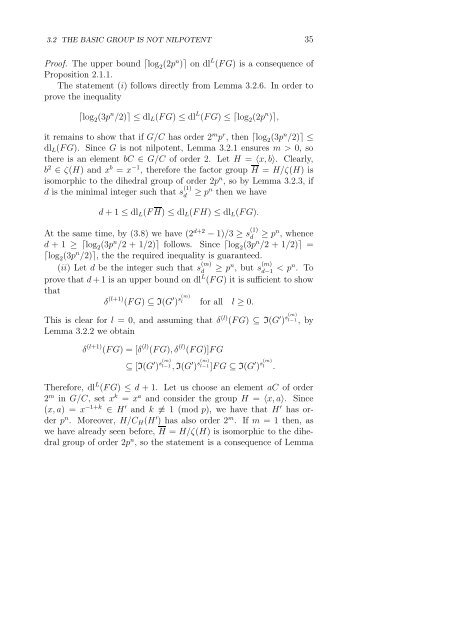On the Derived Length of Lie Solvable Group Algebras
On the Derived Length of Lie Solvable Group Algebras
On the Derived Length of Lie Solvable Group Algebras
Create successful ePaper yourself
Turn your PDF publications into a flip-book with our unique Google optimized e-Paper software.
3.2 THE BASIC GROUP IS NOT NILPOTENT 35<br />
Pro<strong>of</strong>. The upper bound ⌈log 2(2p n )⌉ on dl L (F G) is a consequence <strong>of</strong><br />
Proposition 2.1.1.<br />
The statement (i) follows directly from Lemma 3.2.6. In order to<br />
prove <strong>the</strong> inequality<br />
⌈log 2(3p n /2)⌉ ≤ dlL(F G) ≤ dl L (F G) ≤ ⌈log 2(2p n )⌉,<br />
it remains to show that if G/C has order 2 m p r , <strong>the</strong>n ⌈log 2(3p n /2)⌉ ≤<br />
dlL(F G). Since G is not nilpotent, Lemma 3.2.1 ensures m > 0, so<br />
<strong>the</strong>re is an element bC ∈ G/C <strong>of</strong> order 2. Let H = 〈x, b〉. Clearly,<br />
b 2 ∈ ζ(H) and x b = x −1 , <strong>the</strong>refore <strong>the</strong> factor group H = H/ζ(H) is<br />
isomorphic to <strong>the</strong> dihedral group <strong>of</strong> order 2p n , so by Lemma 3.2.3, if<br />
d is <strong>the</strong> minimal integer such that s (1)<br />
d ≥ pn <strong>the</strong>n we have<br />
d + 1 ≤ dlL(F H) ≤ dlL(F H) ≤ dlL(F G).<br />
At <strong>the</strong> same time, by (3.8) we have (2 d+2 − 1)/3 ≥ s (1)<br />
d ≥ pn , whence<br />
d + 1 ≥ ⌈log 2(3p n /2 + 1/2)⌉ follows. Since ⌈log 2(3p n /2 + 1/2)⌉ =<br />
⌈log 2(3p n /2)⌉, <strong>the</strong> <strong>the</strong> required inequality is guaranteed.<br />
(ii) Let d be <strong>the</strong> integer such that s (m)<br />
d<br />
≥ pn , but s (m)<br />
d−1 < pn . To<br />
prove that d + 1 is an upper bound on dl L (F G) it is sufficient to show<br />
that<br />
δ (l+1) (F G) ⊆ I(G ′ ) s(m)<br />
l for all l ≥ 0.<br />
This is clear for l = 0, and assuming that δ (l) (F G) ⊆ I(G ′ ) s(m)<br />
l−1, by<br />
Lemma 3.2.2 we obtain<br />
δ (l+1) (F G) = [δ (l) (F G), δ (l) (F G)]F G<br />
⊆ [I(G ′ ) s(m)<br />
l−1 , I(G ′ ) s(m)<br />
l−1]F G ⊆ I(G ′ ) s(m)<br />
l .<br />
Therefore, dl L (F G) ≤ d + 1. Let us choose an element aC <strong>of</strong> order<br />
2 m in G/C, set x k = x a and consider <strong>the</strong> group H = 〈x, a〉. Since<br />
(x, a) = x −1+k ∈ H ′ and k ≡ 1 (mod p), we have that H ′ has order<br />
p n . Moreover, H/CH(H ′ ) has also order 2 m . If m = 1 <strong>the</strong>n, as<br />
we have already seen before, H = H/ζ(H) is isomorphic to <strong>the</strong> dihedral<br />
group <strong>of</strong> order 2p n , so <strong>the</strong> statement is a consequence <strong>of</strong> Lemma


